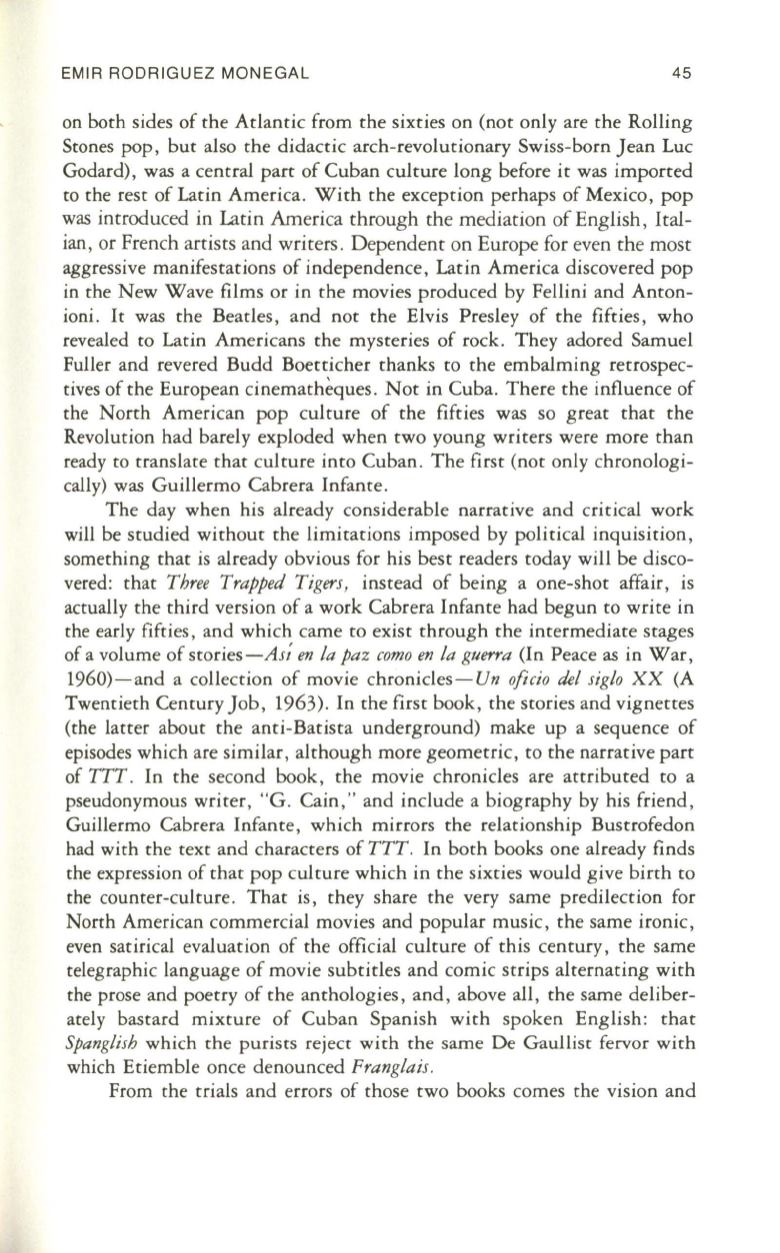
EMIR RODRIGUEZ MONEGAL
45
on both sides of the Atlantic from the sixties on (not only are the Rolling
Stones pop, but also the didactic arch-revolutionary Swiss-born Jean Luc
Godard), was a central part of Cuban culture long before it was imported
to
the rest of Latin America. With the exception perhaps of Mexico, pop
was introduced in Latin America through the mediation of English, Ital–
ian, or French artists and writers . Dependent on Europe for even the most
aggressive manifestations of independence, Latin America discovered pop
in the New Wave films or in the movies produced by Fellini and Anton–
ioni.
It
was the Beatles, and not the Elvis Presley of the fifties, who
revealed to Latin Americans the mysteries of rock. They adored Samuel
Fuller and revered Budd Boetticher thanks to the embalming retrospec–
tives of the European cinematheques. Not in Cuba. There the influence of
the North American pop culture of the fifties was so great that the
Revolution had barely exploded when two young writers were more than
ready
to
translate that culture into Cuban. The first (not only chronologi–
cally) was Guillermo Cabrera Infante.
The day when his already considerable narrative and critical work
will be studied without the limitations imposed by political inquisition,
something that is already obvious for his best readers today will be disco–
vered: that
Three Trapped Tigers,
instead of being a one-shot affair, is
actually the third version of a work Cabrera Infante had begun to write in
the early fifties, and which came to exist through the intermediate stages
of a volume of stories-As!
en la paz como en la guerra
(In Peace as in War,
1960)-and a collection of movie
chronicles-Un oficio del siglo
XX (A
Twentieth Century Job, 1963). In the first book, the stories and vignettes
(the latter about the anti-Batista underground) make up a sequence of
episodes which are similar, although more geometric, to the narrative part
of
TTT.
In the second book , the movie chronicles are attributed to a
pseudonymous writer, "G. Cain, " and include a biography by his friend,
Guillermo Cabrera Infante, which mirrors the relationship Bustrofedon
had with the text and characters of
TTY.
In both books one already finds
the expression of that pop culture which in the sixties would give birth to
the counter-culture. That is, they share the very same predilection for
North American commercial movies and popular music, the same ironic,
even satirical evaluation of the official culture of this century, the same
telegraphic language of movie subtitles and comic strips alternating with
the prose and poetry of the anthologies, and, above all , the same deliber–
ately bastard mixture of Cuban Spanish with spoken English : that
Spanglish
which the purists reject with the same De Gaullist fervor with
which Etiemble once denounced
Franglais.
From the trials and errors of those two books comes the vision and


